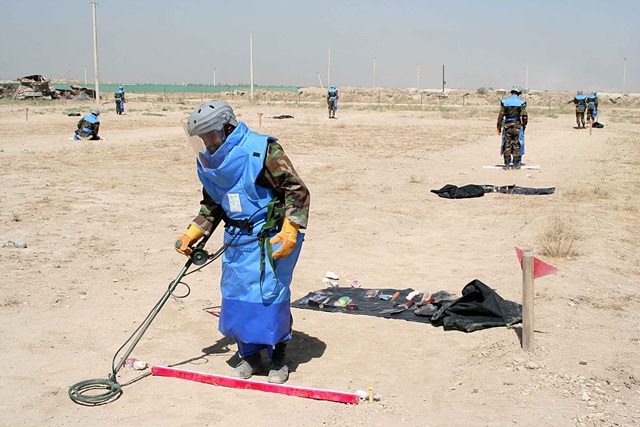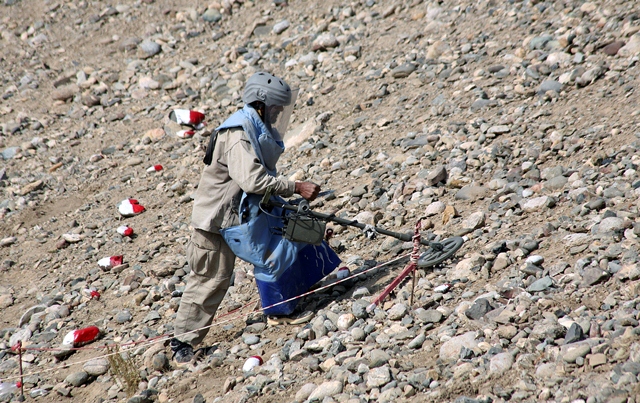UN-backed agency cleared over 1,900 minefields in Afghanistan last year – report
KABUL - A United Nations-supported mine action programme in Afghanistan made significant progress by clearing over 1,900 hazardous areas – covering 112 square kilometres of land – during the Afghan year of 1391 ending on 20 March 2013, according to a report released on Tuesday.
The ‘Annual Report 1391’ of the Mine Action Programme of Afghanistan (MAPA), which is supported by the UN Mine Action Service (UNMAS) and 21 other international donor countries and organizations, said the Afghan agency also registered a “tremendous decrease” in civilian casualties as a result of its mine clearance operations that first started 24 years ago.
“The year 1391 was an outstanding period for MAPA, where the programme under most of its components could achieve beyond its initial plan,” said the report. It added that a total of 1,925 minefields were released against the initial target of 1,660.
“This dedication and hard work of the MAPA workforces during 1391 resulted in releasing over 112 square kilometers of hazardous land for productive use,” the report added.
The report recorded 397 civilian casualties during the reporting period, which the agency said was “a tremendous decrease in the rate of civilian accidents” as compared to 2,116 civilian casualties recorded in the Afghan year of 1380.
“Almost six times reduction in the casualty rate has mainly been the result of clearance and awareness raising efforts carried out by MAPA,” said the report.

The widespread and indiscriminate use of mines and munitions during more than 30 years of conflict has made Afghanistan one of the most heavily contaminated countries in the world.
Since 1989, MAPA has cleared 21,174 minefields and battlefield covering 1,834 square kilometres of land through surveys and clearance operations. As a result, 123 Afghan districts (out of about 400 districts) and 2,243 communities are no longer affected by known landmines and explosive remnants of war (ERW).
Despite the past achievements, Afghanistan still has nearly 5,000 areas covering about 545 square kilometres of land contaminated with mines and ERW, directly affecting over 1.3 million people, said the report.
Due to the scale of the problem, MAPA is one of the largest mine action programmes in the world.
“Due to the protracted conflict and widely spread of mines and explosive remnants of war, there is justified concern to just check those areas for possible contamination prior to the start of construction works,” said the report.
Afghanistan is a signatory to the Ottawa Mine Ban Treaty – officially known as the Convention on the Prohibition of the Use, Stockpiling, Production and Transfer of Anti-Personnel Mines and on their Destruction – which aims to eliminate anti-personnel landmines around the world. In December last year, the state parties to the treaty approved Afghanistan’s request to extend its 2013 deadline for becoming mine-free by 2023.

The UN Secretary-General’s Deputy Special Representative for Afghanistan and the UN Humanitarian Coordinator for the country, Mark Bowden, has previously said that the demining projects undertaken in partnership with Afghanistan’s peace and reintegration programme continues to support broader peace building efforts.
The Programme Manager of UNMAS in Afghanistan, Abigail Hartley, wrote in the report that “a great deal was achieved in 1391,” thanks to 14,000 Afghans working in the programme all over the country.
“I am proud of the capacity building efforts undertaken by UNMAS and demonstrated in an all-Afghan MACCA [Mine Action Coordination Centre of Afghanistan] undertaking effective and efficient coordination in close partnership with Department of Mine Clearance (DMC) without day to day management by international technical advisors,” said Ms. Hartley.
The funding target for 1391 was $98.6 million including the coordination cost of mine action. Of this total, said the report, MAPA received $96.6 million from donors including the Government of Afghanistan, through the UN Voluntary Trust Fund (VTF), which is administered by UNMAS, and bilaterally to its implementing partners.
“This means that MAPA received almost 98 per cent of its required funding in 1391. The funds received were spent on survey, clearance, mine/ERW risk education, victim assistance and coordination,” the report continued.

The majority of mine and ERW clearance in Afghanistan is mainly carried out by the seven non-governmental organizations. Of them, five are national organizations – Afghan Technical Consultants (ATC), Demining Agency for Afghanistan (DAFA), Mine Clearance and Planning Agency (MCPA), Mine Detection and Dog Centre (MDC), Organization for Mine Clearance and Afghan Rehabilitation (OMAR).
Two international organizations are Danish Demining Group (DDG) and Hazardous Areas Life-Support Organization Trust (HALO Trust).
Related article:
 UN
UN







